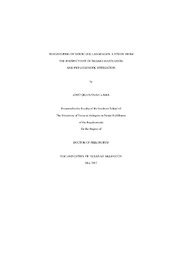| dc.description.abstract | In southwest China and neighboring countries, including Thailand, Laos, Vietnam, and Myanmar, there live over 100 ethnic groups who speak languages known as Nuosu, Naxi, Hani, Lisu, Lahu, etc. These languages belong to the Nisoic Branch or the Loloish Branch of Tibeto-Burman (TB) subfamily of Sino-Tibetan. Though the Nisoic affiliation to TB is unquestionable, its internal subgrouping has not been settled. This dissertation aims to study the internal relationship of 34 Nisoic and three Burmic languages from two perspectives shared innovation and phylogenetic estimation. Shared innovation has been regarded as the most reliable criterion in determining subgroups of language descent (Campbell 2004 Historical Linguistics). In this study, evidence from both shared sound changes and shared elements of word formation were used to establish the language relationship of Nisoic and Niso-Burmic as well. The shared innovations were extrapolated from a word database which is composed of 300 core words for each of these 37 languages. The procedure for arriving at Niso-Burmic subgrouping is a bottom-up approach with a belief that language development obeys a binary-split pathway. This comparative study yields 10 Nisoic clusters that can be further combined into eight groups: Nisoish, Lisoish, Kazhuoish, Nusoish, Naxish, Lahoish, Hanoish, and Mondzish. These eight groups and the Burmish group make up the nine members of the Niso-Burmic Branch.Two phylogenetic approaches Bayesian inference and Neighbor-Net were used to estimate the evolution of the Nisoic descent and the Niso-Burmic descent. Of all the 300 words, 246 characters (glosses) were selected to build a database for 38 taxa (37 Niso-Burmic languages and Written Tibetan). The phylogenetic database is a matrix, which is comprised of these 38 taxa and 4099 character states generated from these 246 characters. Bayes Inference and Neighbor-Net were implemented with MrBayes 3.2.1 and SplitsTree 4.12.3 to compute the binary codes converted from this database. The results of the phylograms (trees) produced by MrBayes and networks generated by SplitsTree were almost identical to each other, and they are essentially the same as the subgroups of Nisoic or Niso-Burmic determined by shared innovations. This dissertation suggests that Burmic and Nisoic are not the two language stocks that first split, instead, the Mondzish group split off from Niso-Burmic at the earliest date. The results of this study represent the first comprehensive account of the Nisoic and Niso-Burmic subgrouping and also represent a hypothesis for further research in the field. | en_US |

